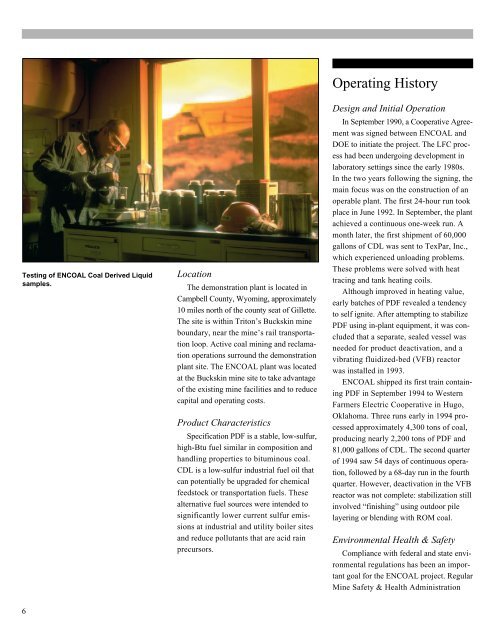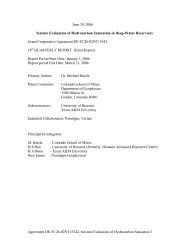Upgrading of Low-Rank Coals - National Energy Technology ...
Upgrading of Low-Rank Coals - National Energy Technology ...
Upgrading of Low-Rank Coals - National Energy Technology ...
You also want an ePaper? Increase the reach of your titles
YUMPU automatically turns print PDFs into web optimized ePapers that Google loves.
Testing <strong>of</strong> ENCOAL Coal Derived Liquid<br />
samples.<br />
6<br />
Location<br />
The demonstration plant is located in<br />
Campbell County, Wyoming, approximately<br />
10 miles north <strong>of</strong> the county seat <strong>of</strong> Gillette.<br />
The site is within Triton’s Buckskin mine<br />
boundary, near the mine’s rail transportation<br />
loop. Active coal mining and reclamation<br />
operations surround the demonstration<br />
plant site. The ENCOAL plant was located<br />
at the Buckskin mine site to take advantage<br />
<strong>of</strong> the existing mine facilities and to reduce<br />
capital and operating costs.<br />
Product Characteristics<br />
Specification PDF is a stable, low-sulfur,<br />
high-Btu fuel similar in composition and<br />
handling properties to bituminous coal.<br />
CDL is a low-sulfur industrial fuel oil that<br />
can potentially be upgraded for chemical<br />
feedstock or transportation fuels. These<br />
alternative fuel sources were intended to<br />
significantly lower current sulfur emissions<br />
at industrial and utility boiler sites<br />
and reduce pollutants that are acid rain<br />
precursors.<br />
Operating History<br />
Design and Initial Operation<br />
In September 1990, a Cooperative Agreement<br />
was signed between ENCOAL and<br />
DOE to initiate the project. The LFC process<br />
had been undergoing development in<br />
laboratory settings since the early 1980s.<br />
In the two years following the signing, the<br />
main focus was on the construction <strong>of</strong> an<br />
operable plant. The first 24-hour run took<br />
place in June 1992. In September, the plant<br />
achieved a continuous one-week run. A<br />
month later, the first shipment <strong>of</strong> 60,000<br />
gallons <strong>of</strong> CDL was sent to TexPar, Inc.,<br />
which experienced unloading problems.<br />
These problems were solved with heat<br />
tracing and tank heating coils.<br />
Although improved in heating value,<br />
early batches <strong>of</strong> PDF revealed a tendency<br />
to self ignite. After attempting to stabilize<br />
PDF using in-plant equipment, it was concluded<br />
that a separate, sealed vessel was<br />
needed for product deactivation, and a<br />
vibrating fluidized-bed (VFB) reactor<br />
was installed in 1993.<br />
ENCOAL shipped its first train containing<br />
PDF in September 1994 to Western<br />
Farmers Electric Cooperative in Hugo,<br />
Oklahoma. Three runs early in 1994 processed<br />
approximately 4,300 tons <strong>of</strong> coal,<br />
producing nearly 2,200 tons <strong>of</strong> PDF and<br />
81,000 gallons <strong>of</strong> CDL. The second quarter<br />
<strong>of</strong> 1994 saw 54 days <strong>of</strong> continuous operation,<br />
followed by a 68-day run in the fourth<br />
quarter. However, deactivation in the VFB<br />
reactor was not complete: stabilization still<br />
involved “finishing” using outdoor pile<br />
layering or blending with ROM coal.<br />
Environmental Health & Safety<br />
Compliance with federal and state environmental<br />
regulations has been an important<br />
goal for the ENCOAL project. Regular<br />
Mine Safety & Health Administration

















